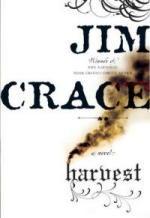
The Narrow Road to the Deep North, by Richard Flanagan
Although its subject matter makes it heavy going, there's no doubt that every fan of literature should read this. Flanagan's novel won the 2014 Booker Prize, and most of it is truly excellent.
The core of the book is set in the Siamese jungle in 1943, and describes in remorseless, horrendous detail the forced labour of Australian prisoners of war during the construction of the Death Railway. Flanagan does about as good a job as anyone could of conveying the relentless misery and suffering inflicted on a few of the hundreds of thousands of victims (mostly Australian, British and Dutch prisoners, along with many more local civilians).

Book Review: Harvest, by Jim Crace
Beginning 400 years ago and continuing until the advent of the First World War, a series of Enclosure Acts moved under private control British land that was previously available for common use. The laws were so named because they involved enclosing open fields with fences, giving legal ownership to a single deed holder.
An inevitable consequence, and catalyst, of industrialization, enclosure allowed for more efficient land usage at the price of massive upheaval. Land formerly cultivated by peasants in an ad-hoc manner could now be farmed systematically, increasing returns. For instance, arable land that was collectively farmed by subsistence peasants using traditional methods and crop rotation was often transformed into pasture land for sheep farming, which was much less labour-intensive and also eliminated the need to leave fields fallow.
Once gaining exclusive control, the new owners were not shy about increasing the rent they charged to those working the land. In many cases, this led to a mass exodus of peasants from the countryside to the industrializing towns and cities; a process that created the working class. Entire villages often disappeared in this way. Riots, rebellions and revolts protesting these changes were commonplace, as were grain shortages and pervasive unemployment.
This is the background to Jim Crace's finely-written, absorbing and memorable novel. Set in a remote village that has minimal contact with the outside world, where very little has changed over many decades. The village is not identified, and no specific time period for the story is indicated, although presumably it is sometime in the seventeenth century. The village has effectively been left to run itself, and for a long time this works well enough, until finally it doesn't.

